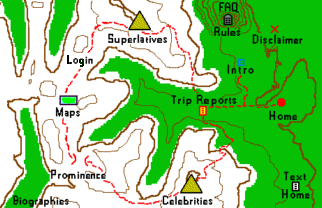
| Prominence-based Parent Hierarchies and Distance Ladders |

|
Ever-widening circles include peaks of successively larger prominence and elevation. Elevation or prominence can serve as the metric for inclusion on a peak list with the criterion that no "closer" peak has a larger value of the given metric.
The "closer" concept is of two types. One is simply the distance. Here, no peak of larger elevation, or of larger prominence, depending on the desired list, may be closer than the given mountain.
The second type employs prominence parentage. A peak's parent is that subjectively grander mountain which determines the given peak's prominence. A good reference is available, attention restricted to the section "PROMINENCE PARENTS (PP)". The type of parent we desire here is the greater prominence parent; and is simply the first summit with larger prominence than the peak in question, located on the saddle walk beyond the given peak's key saddle.
Elevation as the list-building metric suffers because one must specify a cutoff prominence for defining what is a mountain, an arbitrary choice. Furthermore, successive peaks on an elevation-based list may not correspond to our subjective sense of being successively grander. Attention is thus restricted to prominence as the list-building metric.
Two lists are thus presented for a given location - the prominence distance ladder and the prominence parentage hierarchy. A good start for obtaining the distance ladder is Greg Slayden's peak radius search. Enter the center coordinates (with a "-" sign for the Western Hemisphere), and check the box labeled "Prom." at far right under the header "Ladders:". The database contains over ten thousand mountains and thus will contain all major peaks of interest. It will not contain the lesser hills and summits near the specified center. For these nearby list members further investigation is needed.
John Kirk's website maintains a peak radius search as well. Owing to database limitations its usefulness is limited to residents of six western states - Colorado, Idaho, Montana, New Mexico, Utah, and Wyoming.
The distance ladder often results in unusual peak membership since a simple distance metric largely disregards the hierarchical structure of peaks, ridges, and saddles. Continental outlines are also disregarded. Using Maine as center results in Pico Cristobal Colon of Colombia listed in-between Mount Logan and Mount McKinley.
Lists based on specific home locations indicate which peaks have been climbed using the same color identification scheme of county highpointing completion maps. The following differences exist to account for the linear, one-dimensional nature of these lists as distinct from a map's two-dimensions.
 Yellow - The longest
unbroken string of peaks successfully climbed.
Yellow - The longest
unbroken string of peaks successfully climbed.
 Blue - All other scaled peaks.
Blue - All other scaled peaks.
 Light Violet - Peaks that you wish to climb someday
Light Violet - Peaks that you wish to climb someday
for which specific plans have not been made.
 Black - Peaks that you have no intention of ever climbing.
Black - Peaks that you have no intention of ever climbing.
For completeness the following analogies to completion map painting are also applied.
 The entire hierarchy of peaks has been climbed.
The entire hierarchy of peaks has been climbed.
 Failed attempt without a subsequent successful effort.
Failed attempt without a subsequent successful effort.
 Concrete plans to climb the peak with a set timeline.
Concrete plans to climb the peak with a set timeline.
Individual Parent Hierarchies and Distance Ladders (arranged alphabetically by last name)

 )
)



 )
)




 )
hierarchies of former residences
)
hierarchies of former residences




 )
)


 )
)
 )
)

 )
)



 )
)
General Parent Hierarchies and Distance Ladders (arranged alphabetically by location)
| back to main prominence page |